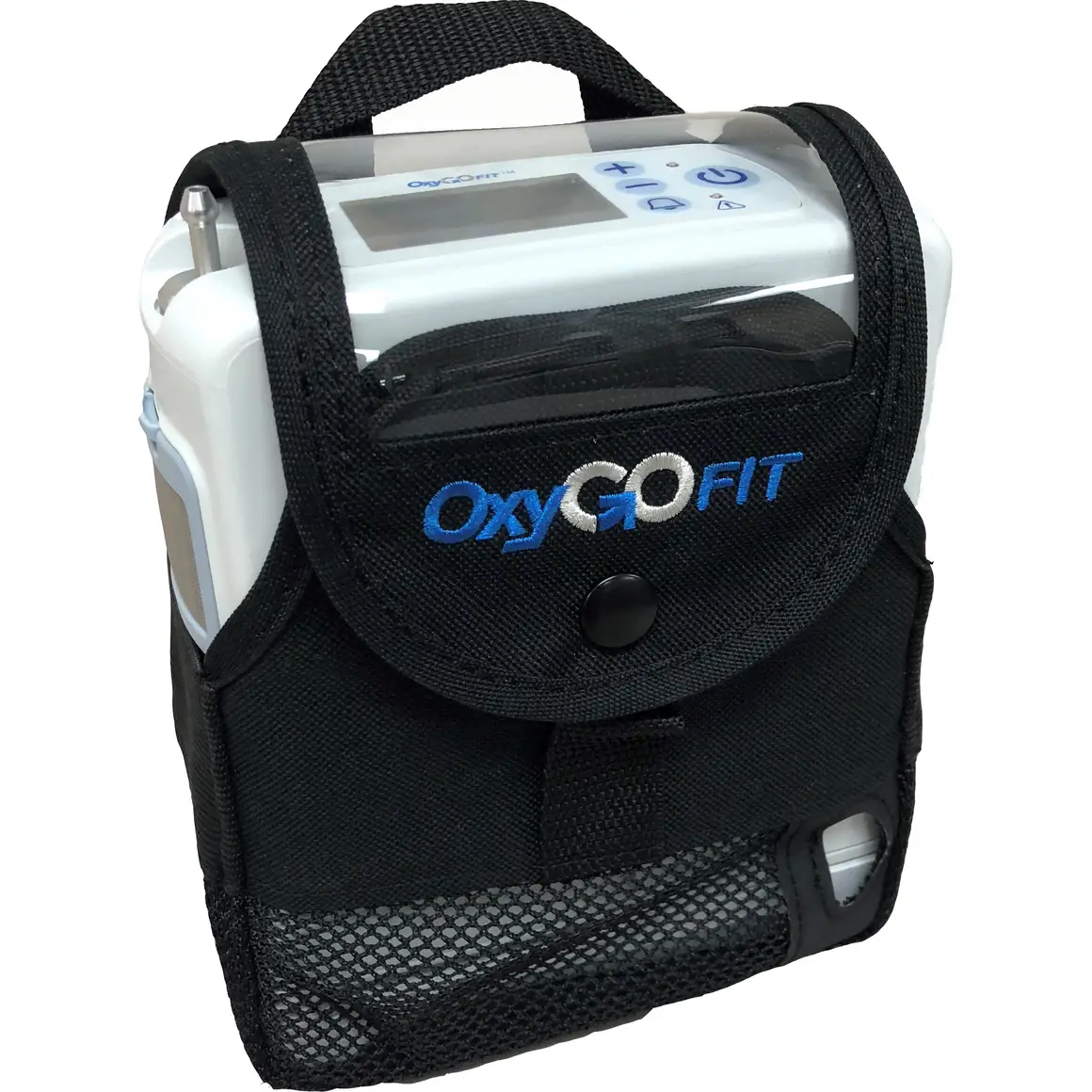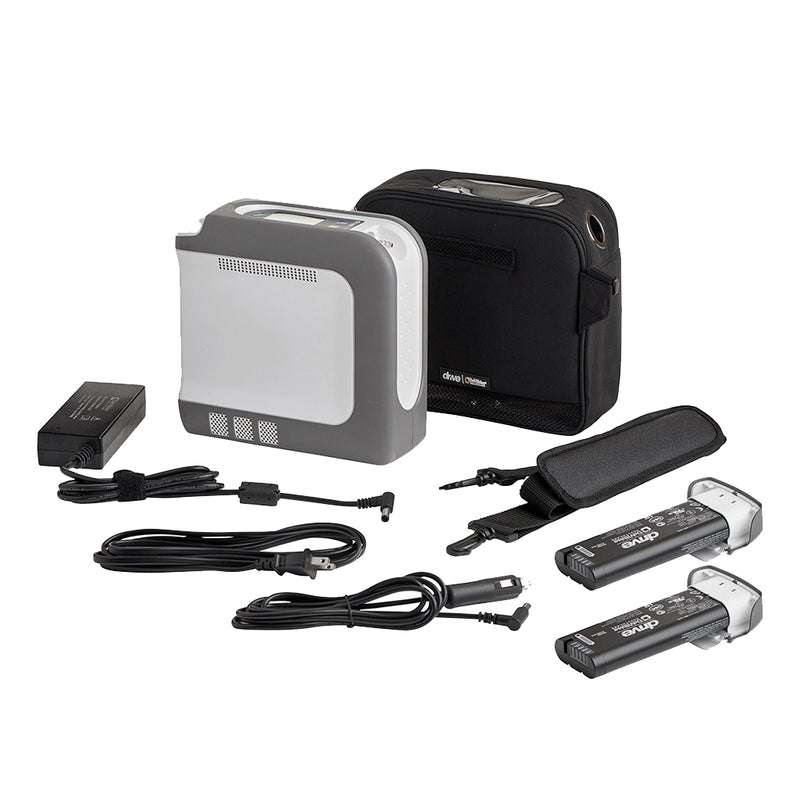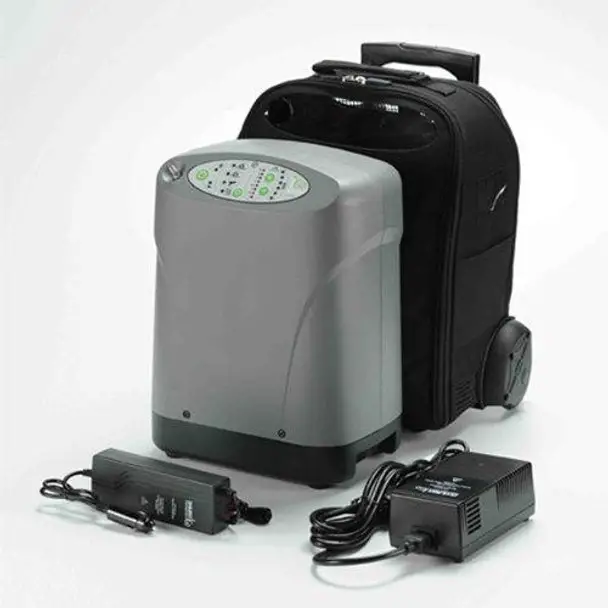Paying For Your Portable Oxygen Concentrator
Portable oxygen concentrators can improve the quality of life for many Chronic Obstructive Pulmonary Disease sufferers. Instead of dragging heavy oxygen tanks around, POCs are much smaller and lighter. Some are small enough to carry in a shoulder bag. People who have POCs are able to remain active in spite of the difficulties of COPD. But because oxygen tanks are the standard of care, POCs are considered luxury items,and medical insurance may not cover one. Before resigning yourself to clumsy oxygen tanks, however, you should first attempt to receive coverage for you portable oxygen concentrator, and if no coverage is possible, there are other alternatives.
What Is Considered Durable Medical Equipment
Durable Medical Equipment, or DME, is a term used by several medical insurance companies, including Medicaid. This word refers to the tools and accessories that patients require in order to fight sickness, keep comfortable, and safe while recovering and that can be used multiple times.
It can include a variety of things like:
The oxygen tank and concentrator are usually on this list since they are medically important for some patients. But does this imply that every patient is entitled to a free oxygen concentrator? Stay tuned for more information in the fine print.
Finding A Specific Code
Some articles contain a large number of codes. If you are looking for a specific code, use your browserâs Find function to quickly locate the code in the article. Sometimes, a large group can make scrolling thru a document unwieldy. You can collapse such groups by clicking on the group header to make navigation easier. However, please note that once a group is collapsed, the browser Find function will not find codes in that group.
You May Like: How Do I Know What Medicare Coverage I Have
Read Also: What Percentage Of The Population Is On Medicare And Medicaid
What Is Your Cost For An Oxygen Concentrator
Assuming you qualify, Medicare may cover part, but not all, of the cost of renting a portable oxygen concentrator. They do not cover purchase costs. Medicares coverage of oxygen equipment and accessories is as follows: If you have original Medicare , youll pay 20% of the Medicare-approved amount after meeting your Part B deductible. A deductible is a set amount designated by an insurance company that the policyholder must pay before the insurance company begins paying any claims. Medicares Part B deductible for 2022 year is $233. So, assuming youve met your deductible for the year, if your DME supplier agrees to rent out a POC for $200 per month, your cost would be 20% of that or $40 per month. A Medicare Advantage plan may pay an even higher proportion of the rental cost, leaving you with a smaller monthly payment.
A DME supplier negotiates a five-year rental contract with Medicare. The initial contract is for 36 months. If your doctor determines that you still need oxygen supplementation after that, the supplier is obligated to provide equipment and supplies to you under that contract for an additional 24 months .
Finally, Medicare Advantage plans include Part B, so they do cover oxygen equipment but they vary in the amount of coverage. Call your provider to discuss their specific coverage plan.
Introducing Our New Portable Oxygen System The Inogen One G4

Finally, you’re no longer stuck at homemissing out on truly living life. We developed one of the 1st portable oxygen concentrators ever, to help get you or your loved one the life-saving oxygen you need – wherever you go. The Inogen One G4 is the smallest system available. This super lightweight, easy-to-use, all-in-one solution provides stationary or portable 24/7 oxygen delivery using the air around you! Offering three flow settings, this system is clinically validated for use 24 hours a day, 7 days a week, using Inogen’s proprietary Intelligent Delivery Technology® to deliver oxygen effectively and efficiently whether you are sleeping, at rest or exerting yourself. No more heavy tanks or refills. It even comes with a convenient carry bag.
- Perfect for home or on-the-go!
- Same purity as large concentrators
- Inogen Connect®, the Bluetooth App, makes monitoring battery life and more super easy
- No tanks to refill or replace
- Ultra-small, discrete, quiet and lightweight
- Rechargeable 5-hour double battery compatible with car ports
- 3 flow settings
You May Like: Does Medicaid Cover Lo Loestrin Fe
Buying An Oxygen Concentrator Out
We realize the purchase of medical equipment is an important decision. As such, we recommend considering the following precautions:
Renting:
Dont Miss: Does Medicare Cover Bed Rails
What Is A Oxygen Concentrator
There are two types of concentrators: a bigger model you can use at home, and a lighter, portable model you can use on the go.
The oxygen concentrator is a machine that filters out the nitrogen and other gases in the air around you, giving you purified oxygen through a thin tube.
There are two types of concentrators: a bigger model that can be used at home, and a lighter, portable model that can be taken on the go.
The concentrator requires electricity and air to work properly. If the power goes out, it wont work until power is restored. It also needs to be cleaned every few weeks or so to prevent bacteria buildup in its internal parts.
An oxygen concentrator isnt the same thing as an oxygen tank, which delivers liquid or gas oxygen. Instead, the concentrator is a machine that pulls in the air around you and filters out the nitrogen.
A thin tube runs from the device to your face, giving you purified oxygen through two open prongs below your nostrils. Some people use a facemask to get a higher concentration and flow of oxygen.
Don’t Miss: Medicaid Fraud Statute Of Limitations
Working With Your Insurance
In order to maximize your chance of insurance covering your portable oxygen concentrator, the first step is making sure your paperwork is in order. Your doctor should write an order for the POC, and also should include all of your relevant medical information such as test results, the severity of your disease, and how often you require oxygen. If your claim is denied, an appeal should fully document why you need a POC instead of an oxygen tank. Take your time writing out all the ways in which having a POC are necessary to maintain your quality of life, including both professional and personal examples. The more details you provide, the more likely you are to convince your insurance to cover your POC.
How To Find An Oxygen Concentrator Covered By Medicaid
Finding a vendor willing to take Medicaid and purchasing or renting an oxygen concentrator are best left to your Medicaid help agents.
You will be required to provide the following documentation:
- A chest exam to establish that you have significant lung illness and difficulty breathing
- A doctors order proving that you require certain devices to preserve your health, containing your diagnosis, name, and other information
- Analyses demonstrating that your arterial blood gas levels are below normal
- Confirmation that other options are not suitable for you
Once you have all of the necessary papers, you may work with your Medicaid reps to obtain the necessary equipment.
Read Also: Can I See A Dentist With Medicaid
What To Do If The Oxygen Equipment Supplier Closes Out Its Business During Your Rental Coverage Period
The supplier must give you a 90-day prior notice in writing stating that they can no longer supply you or provide any oxygen equipment and other services. The notice that they provide must be in any of these forms:
- A notification letter stating their intent that they will no longer provide oxygen therapy services. Moreover, it must also include the last day of the suppliers operation
- A letter to your new supplier stating the transfer of responsibility for oxygen equipment and supplies. It must also include the starting date of the new supplier.
To know more about how to get oxygen equipment and other supplies for different situations on Medicare, you may check this site.
Do You Need A Prescription For Oxygen
Yes, you do. There is a strict criteria for oxygen therapy. Your doctor must provide proof that they recently examined you, along with a detailed diagnosis, explanation of why you require supplemental oxygen and a prescription for your oxygen use, which includes information regarding your flow rate, duration and frequency of use and duration of need.
Also Check: Blue Cross Blue Shield Nevada Medicaid
Also Check: Dentist In Woodbridge Va That Accept Medicaid
Frequently Asked Questions: Medicare And Portable Oxygen Concentrators
Why wont Medicare pay for oxygen concentrators?Medicare does not cover the full cost of purchasing an oxygen concentrator primarily because they have determined that it is more cost-effective for them to cover monthly rentals instead. As such, the answer to why wont Medicare pay for oxygen concentrators is that they will cover part of the cost of the rental, but not purchasing because they have deemed it too costly.
If you decide you want to own your equipment, you should plan to purchase your portable oxygen concentrator on your own. Even if you purchase your portable oxygen concentrator independently, you may still qualify to have certain oxygen equipmentlike cannulas, tubing, emergency oxygen canisters or a humidifiercovered. Inogen can help you learn more about what costs may be covered for you. Give us a call for more information.
View Inogen’s Limited Warranty Statement
G3, G4, G5, Inogen, Inogen At Home, Inogen One, and TAV are trademarks of Inogen, Inc. The usage of any Inogen, Inc. trademarks is strictly forbidden withoutthe prior consent of Inogen, Inc. All other trademarks are trademarks of their respective owners or holders.
The Inogen One portable oxygen concentrators are available by Rx only. For safe and proper use of the Inogen One devices, please refer to
Inogen, Inc.301 Coromar Drive, Goleta, CA 93117
Medicaid And Medicare Coverage On Pocs

Both Medicaid and Medicare indeed cover the rental for oxygen equipment and other accessories, which is classified as Durable Medical Equipment if your primary care physician prescribed it for home use. However, to get you covered for free rental of POC, you must meet the following conditions.
This article will reference Medicare, but Medicaid policy should follow Medicares quite closely. As always, please check with your local Medicaid office and insurance provider first!.
Read Also: Is Sublocade Covered By Medicaid
I Need A Portable Oxygen Concentrator Now What
If youre set on getting a portable oxygen concentrator, youll need to buy from a private supplier, and youll need to fund the purchase yourself. Online stores are good places to start.
Youll need a prescription to buy an oxygen concentrator. This is to make sure youre getting the right amount of oxygen delivered in the right way. Your physician will be able to advise you about whether you need a pulse flow or continuous dose oxygen concentrator, and how much oxygen it needs to provide for you in liters per minute
A reputable store will want to know about your prescription and needs before selling you a portable oxygen concentrator. Its always worth talking to their customer service department first, to make sure youre choosing a machine that suits your needs.
You May Like: Is Aarp Medicare Part D
What Is The Price Of A Portable Oxygen Concentrator
Oxygen concentrators range in price from $1.400 to $3,500, depending on the kind and manufacturer. As you can see, this is not the most economical choice on the market, which is why Medicaid will pay the leasing fee.
If your state does not allow Medicaid to pay the entire cost, you may still be eligible for a price reduction, so make sure to ask all manufacturers and your health insurance carrier for further information.
Don’t Miss: Is Neurofeedback Covered By Medicaid
How Much Does Medicare Pay For Portable Oxygen Concentrators
Original Medicare does cover Inogen, but the beneficiary is responsible for the Part B deductible and a 20% copay. Medicare Part B generally requires beneficiaries to rent, rather than purchase, an oxygen concentrator. The concentrator and supplies must come from a Medicare-approved supplier. Medicare Advantage plans may offer additional coverage.
Read Also: Tens Unit Covered By Medicaid
Do I Need A Prescription For A Portable Oxygen Concentrator
Yes, your doctor must make a specific recommendation and issue a prescription stating that you require an oxygen concentrator. This is especially true if you need to be mobile, on the go, or have another issue that necessitates a transportable oxygen source, as opposed to large oxygen tanks.
The prescription will also mention the type of treatment you need, like:
- How many liters per minute
- Is it a continuous or
- Pulse dose device and other details
Read Also: Is Omnipod Covered By Medicaid
How Does A Portable Oxygen Concentrator Work
A portable oxygen concentrator, sometimes called a POC, is similar to a home oxygen concentrator but more mobile, says Corrielus. These devices are small enough to carry, which makes them ideal for travel, and some are approved for use on airlines.
According to Corrielus, heres how an oxygen concentrator works:
- The device draws in air from your surrounding environment.
- Air is compressed inside the device.
- Nitrogen is filtered out of the air.
- Pure oxygen is inhaled through a nasal tube or mask.
What Does Medicare Cover For Portable Oxygen Concentrators
- Medicare covers portable oxygen concentrators when they are prescribed for use at home.
- Medicare does not cover portable oxygen concentrators when used outside of the home.
- This includes situations where a patient uses them during travel, exercise, or other activities.
Medicare does cover medical equipment and oxygen devices but the key is they do not cover the cost to purchase this equipment outright.
They cover a rental agreement where oxygen equipment can be rented to you monthly for a 36 month agreement.
The problem for many suppliers is that in 2013 Medicare cut their reimbursement rates for oxygen equipment in half.
So, a company would have to purchase the equipment upfront and get paid piece by piece over the next 3 year at a rate that might not be profitable for them.
Hence why we see many companies accept prescriptions for these saying they will cover them but then only giving the patient oxygen tanks instead.
They can bill the whole amount up front for supplies that are ordered each month like oxygen tanks and the tubes needed to use it.
We often get told it is company policy to only allow a patient to get a portable oxygen concentrator when traveling long distance. One company told us they only allow a patient to have a portable oxygen concentrator for 3 days and they have to show proof that they are traveling out of town such that they would need it. It depends on the situation.
For this reason we have seen some companies get creative in getting these.
Recommended Reading: Does Md Anderson Take Medicaid
How Do You Prepare For Hyperbaric Oxygen Therapy
Hyperbaric oxygen therapy requires minimal preparation. Prior to entering the treatment chamber, patients are typically asked to change into scrubs or a hospital-approved gown, remove contact lenses and wash off any petroleum-based skin and hair care products. Your therapeutic team may provide additional instructions.
Best For High Altitude And Traveling: Oxlife Independence Portable Oxygen Concentrator

Courtesy of O2 Concepts
The Oxlife Independence is excellent for traveling due to its operational altitude of 13,123 feet. Unlike other models that top out at 8,000 or 10,000, this portable oxygen concentrator can keep up even up higher and it comes with wheels and a cart handle for easier transportation.
The pulse dose setting ranges from one to six LPM. It also has a continuous setting of one to three LPM for precision oxygen. The battery keeps both pulse dose mode chugging for up to four hours and up to 1.5 hours operating in the continuous mode.
Weight: 16.7 lbs | Delivery/Flow Type: Continuous and pulse flow | Battery Life: 1.5 hours
Patients need to talk to their doctors about if they can handle a portable concentrator to see if their breathing technique and liter flow are adequate from that concentrator to meet their needs. The last thing you want to do is go out and buy a concentrator that doesnt meet the needs of the patient. Dr. Albert Rizzo, M.D., the Chief Medical Officer with the American Lung Association
Recommended Reading: Does Medicaid Cover Tooth Replacement
What Is A Portable Oxygen Concentrator
A portable oxygen concentrator delivers supplemental oxygen to individuals who experience drops in blood oxygen levels due to medical conditions such as COPD, COVID-19 and lung cancer. The device draws oxygen from the air around it, so it doesnt require refillable tanks, making it smaller and lighter than stationary oxygen concentrators. Most POCs are shorter than knee height and are designed to be carried or carted around.
Portable oxygen concentrators come in various sizes, shapes and colors. However, most units feature similar components, which include:
- A knob to adjust the flow rate
- An alarm indicator that signals a loss of power
- A replaceable intake filter
- An outlet for the nasal cannula
- A rechargeable battery or a plug-in power source
Many units also offer optional adapters that plug into vehicles so the POC may be used during travel.